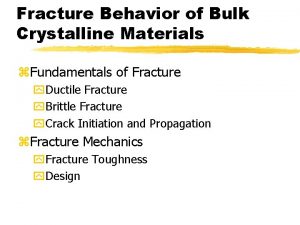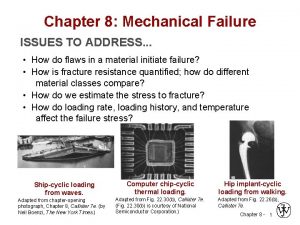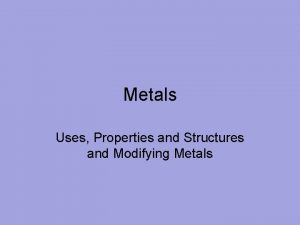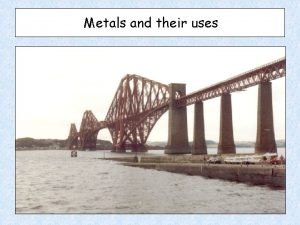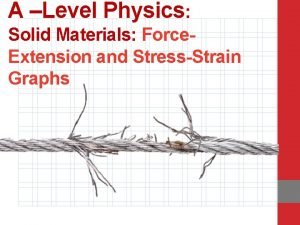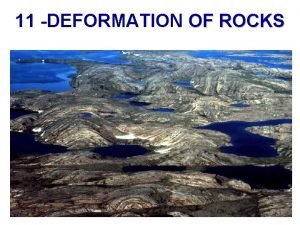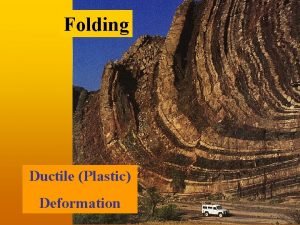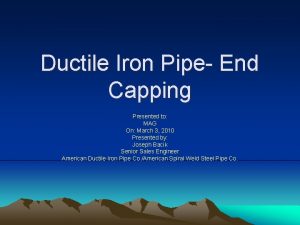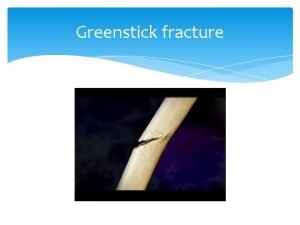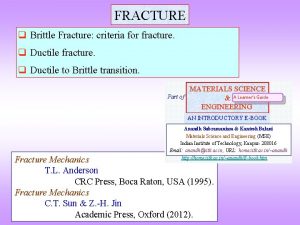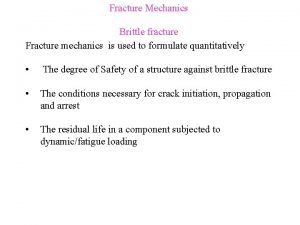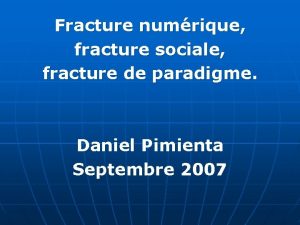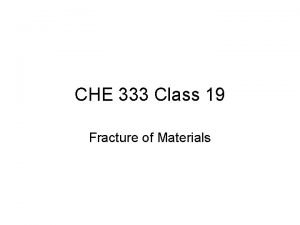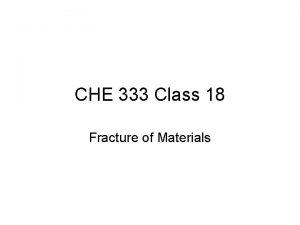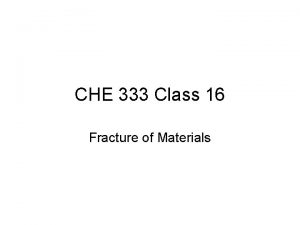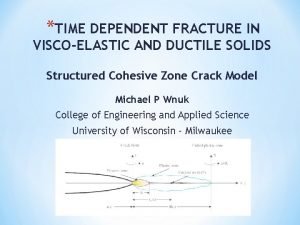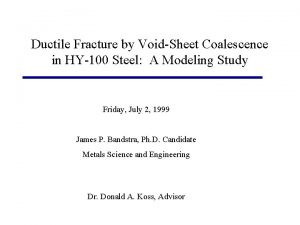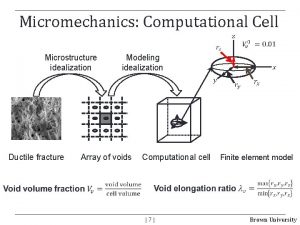DUCTILE FRACTURE TRANSITIONED TO LARGE STRUCTURES John W













- Slides: 13

DUCTILE FRACTURE TRANSITIONED TO LARGE STRUCTURES John W. Hutchinson Harvard University In collaboration with Frank Zok, UCSB Talk Outline Small-scale & Large-scale approaches to ductile fracture Quick review of Extended Gurson Model (small-scale approach) Application of Extended Gurson Model to predict cohesive zone properties for XFEM and related approaches for large-scale structures (with assistance of K. L. Nielsen of DTU)

Ductile Fracture: Approaches at Two Scales I--High resolution approaches based on ductile fracture mechanisms Employs damage moderated constitutive models such as extended Gurson Model which require meshing to scale with size of the fracture process—typically in the range from 30 to 100 microns. This approach is only feasible for component analysis and for calibrating input to low resolution approaches. II--Low resolution approaches for large complex structures A. Critical plastic strain (e. g. , Hancock-Mackenzie & Johnson-Cook Compact tension specimen Employs critical value of the effective plastic strain (depending on stress triaxiality). Must be calibrated against basic experiments or possibly high resolution results. Usually used with element deletion to simulate cracking. Major issues related to failure under tearing versus shearing situations. B. Embedded discontinuity & XFEM methods Employs cohesive zone to represent entire failure process including shear and necking localizations and final shear-off fracture. For a plate structure, the mesh size can be large compared to the plate thickness. This approach has to be calibrated against experiment and/or by high resolution simulations. It is intended for failure analysis of complex large structures. These methods will soon be operational in commercial codes. All approaches require calibration against experimental data Meter-size plate

Triaxiality= Data of Bao & Weirzbiski (2004)

New (unpublished) Experimental Data from J. Faleskog, KTH Fracture strain is NOT monotonically decreasing with Triaxiality Intermediate strength steel: Weldox 420 Combined Torsion/Tension Trend-line for standard Johnson-Cook Fracture occurs in notched section Axisymmetric stressing Torsion (No overall tension) Tension (No overall Torsion)

Damage model: Extended Gurson Model (Nahshon & Hutch, 2008) Yield surface: Reduces to J 2 flow theory with no damage (f=0) Plastic strain rate and flow law: nothing changed Damage rate: In pure shear: extension No change to model for axisymmetric stress states Note: Without extension, Gurson Model implies no damage growth if mean stress is zero, e. g. in pure shear. Pure & simple shear behavior

Calibration of Extended Gurson Model using Three Tests: Example for DH 36 steel (Xue, Pontin, Zok & Hutch, 2009) Round bar tension Summary: For DH 36, Compaction tension Mode I fracture Mode II shear-off

Demonstration of Model Capabilities with further applications to DH 36 --Prediction of final rupture strain and cup-cone fracture mode Round Bar Notched Round Bar

Predictions for DH 36 Based on Extended Gurson Model Standard Gurson Model prediction Simulations of KTH Torsion/Tension Test What’s Wrong with Johnson-Cook? Nothing that an extra parameter can’t cure!

First steps at developing cohesive zone characterizations for ductile fracture of sheets and plates for inclusion in XFEM & related large scale numerical codes Kim L. Nielsen (DTU) and John Hutchinson Onset of necking Onset of shear localization Cohesive Energy Progression of ductile fracture Ductile fracture of a meter size plate with thickness about 1 centimeter. The slant shear fracture flips back and forth as the crack advances Simonsen & Tornqvist (2004) Plane strain tension simulations— The contribution to the cohesive traction law is that following the onset of necking

The onset of shear localization and the subsequent ductile failure process based on the extended Gurson model Local effective plastic strain at center of neck Critical effective plastic strain at shear localization bifurcation 0. 62 0. 47 0. 43 0. 39 0. 34 0. 32 0. 27 0. 23 0. 32 Local effective plastic strain at center of neck 0. 20 Comparison with bifurcation analysis: The full numerical simulation predicts the onset of localization in essentially perfect agreement with bifurcation analysis. Effective plastic strain from bifurcation analysis Onset of necking

Minor Effect of boundary constraint in plane strain simulations The difference between a tall plate and a short plate constrained by loading grips Free vs. Constrained specimen F F (f 0 =0. 01, N=0. 1) With a mesh size : ~ 0. 015 W 0 Constraint Free

Characterizing the energy dissipated in the final failure process or, equivalently, the mesh size dependency of dissipated energy after localization Independent of mesh size & scales precisely with thickness Depends on thickness of shear-off process zone and dependent on mesh size, but does not scale with thickness of plate. Element size Normalized cohesion energy as a function of mesh size or, equivalently, the width of the localized failure process zone

First steps at developing cohesive zone characterizations for ductile fracture of sheets and plates for inclusion in XFEM & related large scale numerical codes ---Implications of fine scale simulations using the extended Gurson model Most of the cohesive energy is produced in the deformation stage between the onset of necking and the onset of shear localization. The good news is that this contribution scales precisely with the thickness of the plate and is relatively easy to compute. Under the overall plane strain tensile conditions considered here, the energy dissipated during the final failure process after the onset of shear localization is relatively small (no more than 10%). This contribution does depend on the thickness of the final shear-off localization zone and it does not scale with the thickness of the plate. These simulations provide insight into what can be expected from experimental measurement of properties of the cohesive zone for use in codes for analyzing large scale structures.

